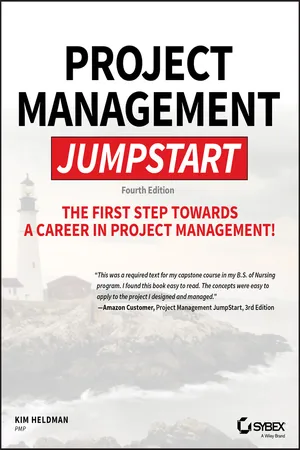
- English
- ePUB (mobile friendly)
- Available on iOS & Android
Project Management JumpStart
About this book
An informative introduction for those considering a career in project management
Project Management JumpStart offers a clear, practical introduction to the complex world of project management, with an entertaining approach based on real-world application. Fully revised to align with a Guide to the Project Management Body of Knowledge –PMBOK Guide©, 6th edition, this book provides an overview of the field followed by an exploration of current best practices. The practical focus facilitates retention by directly linking critical concepts to your everyday work, while the close adherence to PMBOK guidelines makes this book the perfect starting point for those considering certification to earn either PMP or CompTIA Project+ credentials.
Project management is a top-five, in-demand skill in today's workplace, and the demand has spread far beyond IT to encompass nearly every industry; any organization that produces goods or services, whether for profit or not, has a vested interest in ensuring that projects are completed on time, on budget, and to the satisfaction of the client—this is the heart of the project management function. Let Kim Heldman, bestselling author of PMP Study Guide and CompTIA Project+ Study Guide, walk you through the basic principles and practices to help you build a strong foundation for further training.
- Understand current project management methods and practices
- Explore project management from a practical perspective
- Delve into illustrative examples that clarify complex issues
- Test your understanding with challenging study questions
Trillions of dollars are invested in various projects around the world each year, and companies have learned that investing in qualified project management professionals pays off in every aspect of the operation. If you're considering a career in project management, Project Management JumpStart provides an excellent introduction to the field and clear direction for your next steps.
Frequently asked questions
- Essential is ideal for learners and professionals who enjoy exploring a wide range of subjects. Access the Essential Library with 800,000+ trusted titles and best-sellers across business, personal growth, and the humanities. Includes unlimited reading time and Standard Read Aloud voice.
- Complete: Perfect for advanced learners and researchers needing full, unrestricted access. Unlock 1.4M+ books across hundreds of subjects, including academic and specialized titles. The Complete Plan also includes advanced features like Premium Read Aloud and Research Assistant.
Please note we cannot support devices running on iOS 13 and Android 7 or earlier. Learn more about using the app.
Information
Chapter 1
Building the Foundation
IN THIS CHAPTER
- The definition of project management

- Different organizational structures

- The project management process groups

- Project criteria

- Constraints and their impacts

- Project management certification


The Project Management Journey
Is It a Project?
| Projects | Ongoing operations |
| Definite beginning and end. | No definitive beginning and end. |
| Temporary in nature. | Ongoing. |
| Produces a unique product, service, or result. | Produces the same product, service, or result over and over. |
| Resources are dedicated to the project. | Resources are dedicated to operations. |
| Ending is determined by specific criteria. | Processes are ongoing. |
Where Are We Going?
Table of contents
- Cover
- Title page
- Copyright
- Dedication
- Acknowledgments
- About the Author
- Introduction
- Chapter 1 Building the Foundation
- Chapter 2 Developing Project Management Skills
- Chapter 3 Initiating the Project
- Chapter 4 Defining the Project Goals
- Chapter 5 Breaking Down the Project Activities
- Chapter 6 Planning and Acquiring Resources
- Chapter 7 Assessing Risk
- Chapter 8 Developing the Project Plan
- Chapter 9 Budgeting 101
- Chapter 10 Executing the Project
- Chapter 11 Controlling the Project Outcome
- Chapter 12 Closing the Books
- Appendix A Answers to Review Questions
- Appendix B Sample Project Management Forms and Checklists
- Glossary
- Index
- End User License Agreement